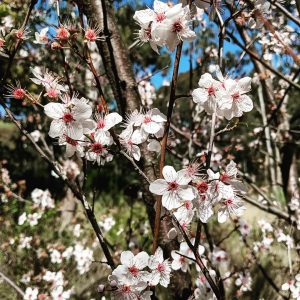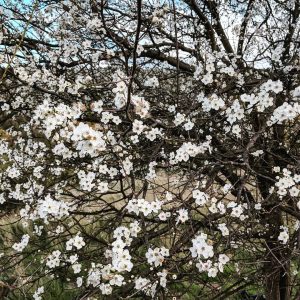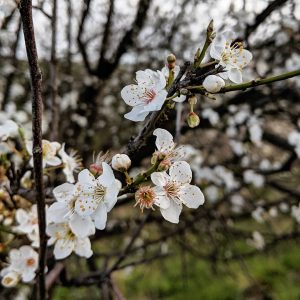Cherry Plum (Prunus cerasifera), a stone fruit native to the Balkans and to Western Asia, adopted and selected for its ornamental qualities (as well as for use as a root stock).
With the introduction of purple-leaved varieties in the late 19th century, Cherry Plum became a popular ornamental selection for Australian temperate gardens. ‘That purple beech kind of look… is so effective in Australian shrubbery landscape work [and] worthy of notice,’ raved the Sydney Mail in 1921.
A 1915 account in the Leader newspaper of springtime conditions at the Melbourne Botanic Gardens, similarly celebrated the presence of Cherry Plum. While we might trust that the gardeners had every command of the shrubberies at the Domain, the image now conjured is startlingly predictive: ‘The purple-leaved cherry plum trees… are judiciously scattered about the gardens [and] will continue for the next few days to be striking features amongst the vegetation.’
Naturalised specimens were reported from NSW in 1935, when the species was found established on a roadside in the Kangaroo Valley. Here in Victoria, Portland orchardist and heroic amateur A.C. Beauglehole recorded introductions across the state in the late 1970s, from Ararat and the southern Grampians, to the Hallston Forest in Gippsland, to Reedy Creek outside of Eldorado in the north-east. It had also shown up in the Mullum Mullum Creek here in Melbourne. However, given the breadth of its suddenly recognised occurrences, Cherry Plum was surely out in the environment earlier than this, escaping botanical remark while sending its ephemeral white-pink flares up year on year from anonymous bushland parcels across the state.
The photographed plants were present in various positions along the valley of the Maribyrnong River and on its shoulders, laden with blossoms in the first week of September. The blanket ID is a relatively safe bet, although I admit that there’s a chance another peach or plum has slipped through.
View Original Post on Instagram
Search for information about Prunus cerasifera in the Flora of Victoria
View information and occurrences of Prunus cerasifera on the Atlas of Living Australia










